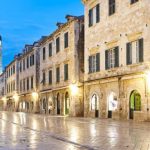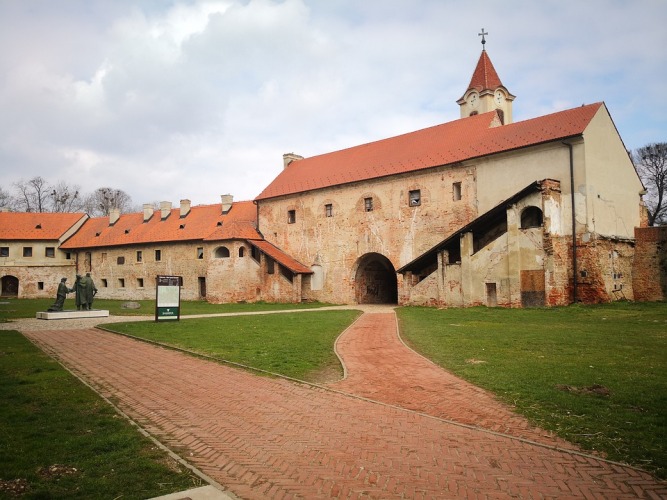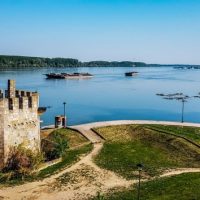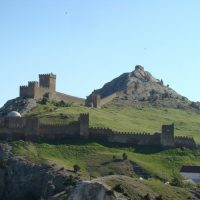Europe is a magnificent place to find thousands of castles in beautiful locations ranging from city centers to remote countryside.
Walking around old castle grounds is an excellent chance to step back to the days of royal families, monarchal power, and a feudal system.
When thinking of castles, most consider the British Isles, Ireland, France, and Germany.
However, all European countries have some castles, which are plentiful in Croatia.
With such a diverse landscape, many Croatian castles were built on stunning seaside locations or atop picturesque mountains, but not for the view, for protection against invaders.
If you’ve ever wondered about the most beautiful castles in Croatia, keep reading to learn more!
15 Most Beautiful Castles in Croatia
While there are numerous castles to explore and enjoy the well-manicured grounds.
Cakovec Castle
Renovated multiple times during its long history, Cakovec Castle was most recently transformed in 1738 after an earthquake hit the area.
The castle was reconstructed with stunning Baroque architecture.
Visitors will quickly understand from the old undamaged walls that Cakovec Castle was used as a highly fortified military structure beyond the royal family’s residence.
Today, the castle hosts the Museum of Medimurje Cakeovec, where various artifacts and portraits of the ruling family are held.
The castle also boasts Zrinski Guards, who remain to honor the ancient ruling family.
Cetin Castle
Located three miles from the town of Cetingrad, like most castles on this list, Cetin Castle is perked high on a giant hill protecting the area.
Unfortunately, little information is available about the castle, which dates back to 1334, but many believe a Roman settlement existed on this site at some point in history.
Although the castle is in ruins, the top view is magnificent, and touring the old ruins gives you a deep sense of the history and culture of the area.
Dubovac Castle
Standing proud on a hill protecting Karlovac City is Dubovac Castle, built in the 13th century in a Renaissance architectural style.
Today, the castle continues to be well-maintained and well-preserved, so it’s a popular summer option for those seeking history combined with dramatic views.
The castle has changed hands multiple times throughout its history and was most recently restored in the 20th century.
While the castle is beautiful, it’s highlighted more by the many legends and stories surrounding it.
Once inside the complex, there is a castle museum and restaurant to have a nice quiet lunch surrounded by history.
Kamerlengo Castle
Another castle located close to Split is Kamerlengo Castle.
The Trogir neighborhood surrounding the castle has become a trendy destination in recent years due to its history and tourism.
As a result, new restaurants, bars, shops, and other attractions have opened.
Kamerlengo Castle was built in the 15th century at the bend of the river, so watchmen could monitor the boats entering and leaving the city.
Klis Fortress
Nestled atop a cliff near Klis, Croatia, just outside Split, is the Klis Fortress, one of the most picturesque ancient castles in the country.
Located on the Dalmatian Coast, Klis Fortress is one of the many citadels that dot the mountains.
If you’re visiting Split, Klis Fortress is a mandatory destination and easily one of the best in the country to see.
Dating back to the 2nd century BC, the site was originally a fort for the Dalmatae tribe.
In 9 AD, the Romans conquered it and named the site Clausura which evolved to Clarissa, then Klis.
Mailath Castle
Situated in the northeasternmost point of Croatia, Mailath Castle is one of the most beautiful and one of the last built in this region.
Although it started as a much smaller castle, Emperor Franz Joseph expanded the site in 1903 in the British style.
The grounds now house the municipal administration for the city.
Miljana Castle
Close to Veliki Tabor is Milana Castle, a stunning stronghold that dates to the 16th century and was built for the Ratkay family.
In the 20th century, the grounds were restored, making it one of the best-preserved castles in the country.
Inside the castle is a treat with extensive astrological paintings alongside a private art collection.
Morosini Grimani Castle
Situated in Svetvincenat, Morosini Grimani castle is a medieval style with picturesque Renaissance architecture.
The castle is named after the two former owners and was constructed in 983.
While the castle was renovated in 1589, it has retained much of its original beauty, including the massive cistern in the center of the courtyard.
Nehaj Castle
Approximately a two-hour drive from Zagreb is the beautiful town of Senj, on the Croatian coast, which hosts Nehaj Castle.
Nehaj is a Croatian word that means “do not worry” to reassure residents that the fortress and inhabitants will protect them from land or sea invaders.
For the best views panoramic views of the city, climb to the top of the castle.
Orsic Castle
Located in Gornja Stubica, Orsic Castle belongs to the beautiful Baroque era.
The castle was used until 1924 as a residence for the Orsic family.
In the 1960s, the castle was restored and modified to include the Museum of the Peasant’s Revolt, a tragic event when peasants revolted against Franjo Tahy in 1573 for cruel treatment.
The revolt lasted 12 days and ended with the leader publicly tortured and quartered.
Later, many writers and artists paid tribute to this courageous hero.
His heroism was so well recognized by the country that during World War II, a Slovenian and Croatian brigade was named in his honor.
Ozalj Castle
Located on the picturesque Kipa River, Ozalj Castle is in the town with the same name, which boasts a glorious and rich past.
Ozalj Old Town, including the castle, is located just 34 miles from Zagreb, which is an easy day trip by public transit, train, or car.
Situated on a cliff overlooking the river, this fairytale castle is in the middle of an area with a history dating back over 5,000 years.
Although first mentioned in written texts in 1244, when you visit the Ozalj Castle Museum, you will learn that archaeological artifacts date to prehistoric times.
These include ceremonial jugs, tools, and clay utensils from the Bronze Age.
While these are fascinating pieces of history, Ozalj shined during the Middle Ages when the noble Frankopan and Zrinski families ruled the land and shaped history.
Starigrad Fortress
Located in the Split region is the town of Omis, the place where the 15th-century Starigrad Fortress resides.
Nestled on the top of a cliff overlooking the beautiful Adriatic Sea, the castle boasts incredible views but was built as a lookout and defensive structure against the Ottoman Empire.
Many of these castles were constructed for this specific purpose.
While they made for stunning summer residences for noble families, they served a much more militaristic purpose.
Trakoscan Castle
Situated atop a sharp sloped hill in Hrvatsko Zagorje is Trakoscan Castle, one of the most famous in Croatia.
Overlooking the perfectly manicured gardens and manmade lake, Trakoscan can be reached in as little as one hour from Zagreb, the country’s capital.
Also within proximity is Maria Bistrica, a Pilgrimage town, and Varazdin, a stunning baroque city.
This famous castle is an easy day trip from many locations in Croatia.
Constructed in the 13th century, the original owner is unknown, but the castle was created to function as a fortress.
Over the past nine centuries, Trakoscan has been owned by numerous individuals or families, now belonging to the Croatian government.
Varazdin Castle
Predating the town of Varazdin, this castle was constructed in the 12th century, centuries before the city was built in the 16th century.
This majestic stronghold has undergone countless transformations and renovations over the year, with the square tower being the oldest section still standing.
At the time of construction, the castle featured a moat and multiple towers.
When visiting, you will notice that the moat is filled in, and the architectural styles are heavily influenced by the Baroque and Renaissance periods.
The stark white walls provide a fantastic contrast against the red-tiled roof and green countryside.
Veliki Tabor Castle
Similar to Trakoscan Castle, since it sits on a hill with cliffs, Veliki Tabor Castle stands proud over the stunning Hrvatsko Zagorje Valley.
While the official construction date is unclear, most experts accept that it was built in the 12th century and was regularly renovated since, with the most recent being a few years ago.
Featuring four towers that form a horseshoe, Veliki Tabor Castle may not be the grandest, but its beautiful and unique architecture has placed it on the Croatia UNESCO Tentative list.
In addition, each day during peak season, there is some sort of performance or workshop on the castle grounds, which is excellent for children to learn more about the history of this location.
Croatia Safety Overview
READ THE FULL REPORT: Croatia Safety Review
Safety Index:
- OVERALL RISK: LOW
- TRANSPORT & TAXIS RISK: LOW
- PICKPOCKETS RISK: MEDIUM
- NATURAL DISASTERS RISK: LOW
- MUGGING RISK: LOW
- TERRORISM RISK: LOW
- SCAMS RISK: MEDIUM
- WOMEN TRAVELERS RISK: LOW
Frequently Asked Questions
How many castles are in Croatia?
With over 110 castles and 7,000 ancient structures, Croatia is not just worth visiting for its beautiful beaches.
The country is chock full of history, with locations scattered throughout the country and in cities.
What is the weakest part of a Croatian castle?
Castles were created to withstand an enemy attack, so builders added numerous defensive features to make an attack and overthrow difficult.
The weakest part of a Croatian castle is the entrance.
While many castles featured moats with a drawbridge that could be pulled up, and the entrance was often a thick iron door, it was also where multiple materials with joints and other weak points met.
What does every Croatian castle need?
As you likely have noticed from this list, every Croatian castle needs a prime location on a cliff, bend of water, or over an older fortification where ruins can successfully be used.
Castles also need access to food and water supplies and a permanent defensive force, all of which are critical to protecting the castle and inhabitants, which are significant factors when selecting a location.
Unbelievably, the builders didn’t construct beautiful castles on hilltops for a scenic view.
Instead, they built in these strategic locations to easily spot enemies approaching on the horizon.
What is the most essential room in a Croatian castle?
The most critical room in Croatian castles was the Great Hall.
This is where household members, visitors, politicians, and other vital individuals sit down to eat at tables for all meals.
In addition, on special days and occasions, feasts were held in the Great Hall.
For instance, King Arthur’s famous Pentecost Feast took place in this castle hall type.











